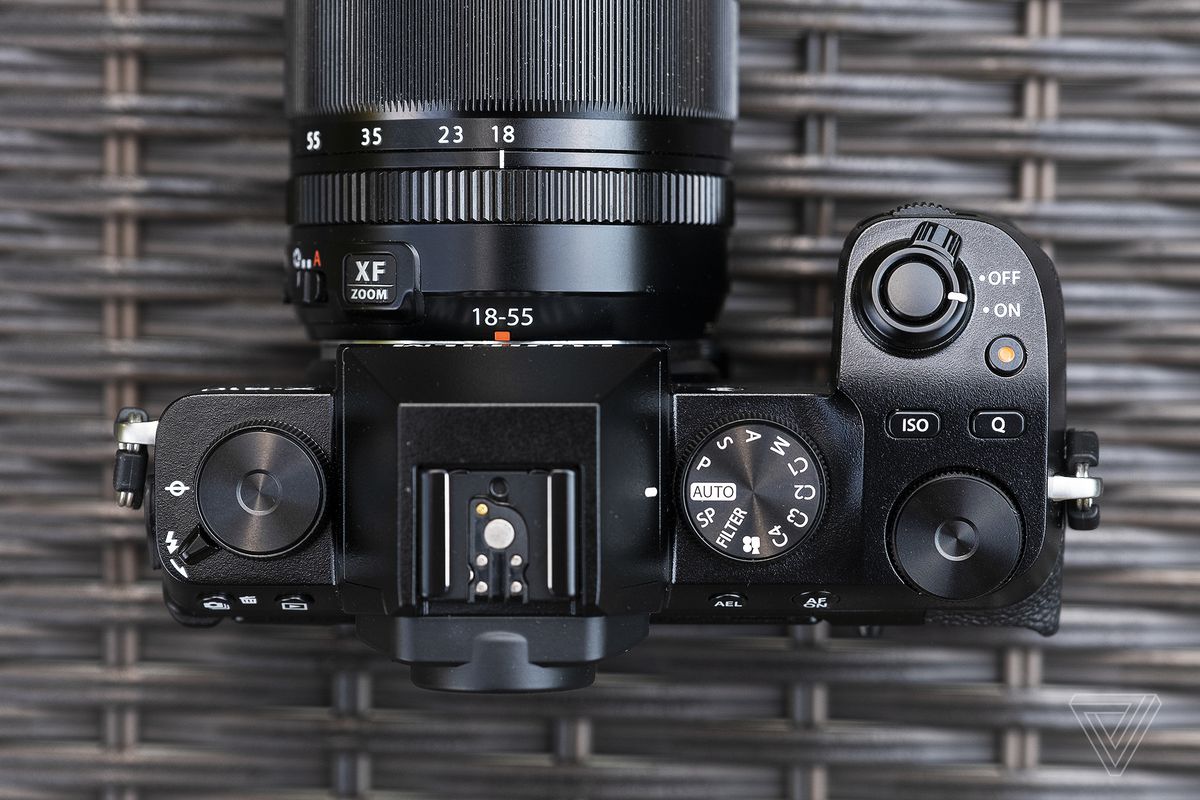Fujifilm has just announced a new camera in its X-series mirrorless lineup, the X-S10. The new model is a bit of a departure from Fujifilm’s other cameras, and features a control scheme that’ll be familiar to shooters of other camera systems. It also has plenty of vlogger-friendly features, including a fully articulating display, in-body image stabilization, and a microphone input.
The X-S10 will be available starting in November for $999.95 without a lens. It will also be kitted with a 18-55 f/2.8-4 lens for $1,399.95, or a 16-80 f/4 lens for $1,499.95.
Unlike Fujifilm’s other cameras, such as the X-T4, X-T3, or X-T30, the X-S10 does away with the traditional shutter speed, ISO, and exposure compensation dials in favor of a mode dial and front and rear command dials, like many Canon, Nikon, and Sony cameras have. It also has an unlabeled dial on the left shoulder for switching between the X-S10’s 18 film simulations. This setup will be foreign to existing Fujifilm owners, but it may make the camera more appealing to those coming from other systems.
:no_upscale()/cdn.vox-cdn.com/uploads/chorus_asset/file/21941177/dseifert_201001_4224_0002.0.jpg)
The X-S10 also features a prominent grip, which is larger than found on most prior Fujifilm cameras. The grip makes it easier to hold the camera one-handed and removes the need to add accessories to beef up the handling. Sadly, the grip isn’t large enough to accommodate the X-T4’s larger battery — the X-S10 uses the same 1,260mAh W126S battery found in many older Fujifilm cameras. It also gives up the dual SD card slots found on the higher-end models and makes do with a single UHS-I slot.
Like the X-T4, Fujifilm is pitching the X-S10 as a hybrid camera, meaning it should appeal to both still photographers and video shooters. It has the same 26.1-megapixel X-Trans IV CMOS sensor, X-Processor 4, and autofocus system as the X-T3 and X-T4, but it doesn’t quite match those models in terms of video capabilities. The X-S10 can shoot 4:2:2 10-bit 4K video at 30 frames per second, but only to an external recorder — internal recording is limited to 4:2:0 8-bit. It does retain video features such as high-speed full HD video at 240fps, F-Log, and zebras, however.
Fujifilm says the five-axis in-body image stabilization (IBIS) system in the X-S10 is both 30 percent smaller and 30 percent lighter than the one used in the X-T4. That allows the camera itself to be more compact, but it gives up about half a stop of shake compensation compared to the X-T4, maxing out at 6 stops.
The X-S10’s microphone jack is mounted above the articulating touchscreen’s hinge, so a microphone cable won’t block the view of the screen when it’s flipped around, but there’s no headphone jack. A USB-C to 3.5mm adapter is included in the box to monitor audio, though the USB-C port does block the screen when it’s flipped around.
:no_upscale()/cdn.vox-cdn.com/uploads/chorus_asset/file/21941173/dseifert_201001_4224_0007.0.jpg)
:no_upscale()/cdn.vox-cdn.com/uploads/chorus_asset/file/21941174/dseifert_201001_4224_0005.0.jpg)
As a lower-tier model than the $1,600 X-T4, the X-S10 includes a handful of improvements to its autoexposure modes. A new feature will allow the camera to automatically choose between Provia, Velvia, and Astia film simulations, depending on the context of the shot, while the Shooting Priority Auto setting allows you to tell the camera what kind of scene you’re shooting and let it take it from there. You can also now capture RAW images in addition to JPEGs in the auto modes, something you couldn’t do on other Fujifilm cameras.
I had an opportunity to briefly use a pre-production X-S10 ahead of today’s announcement. As someone who’s shot with Fujifilm cameras for nearly a decade for both professional and personal work, I found the X-S10’s control scheme off-putting and longed to have my shutter speed and exposure compensation dials back. I also found the camera to not be as customizable as I’d like — instead of seven custom modes, there are only four, and the top left shoulder dial was limited to just adjusting the film simulation, which isn’t something I need a dial dedicated to.
:no_upscale()/cdn.vox-cdn.com/uploads/chorus_asset/file/21941179/dseifert_201001_4224_0006.0.jpg)
But I’m not the target market for the X-S10; that’s the millions of people who are shooting with Canon, Nikon, Panasonic, or Sony cameras who may have shied away from Fujifilm cameras before. Those shooters might not have liked Fujifilm’s throwback control system, or they may have a style of shooting that works better with front and rear command dials. Or maybe they are vloggers, which I am decidedly not, and want something that can be held out at arm’s length and produce a steady shot.
Based on my conversations with Fujifilm representatives, it does seem like the X-S10 is the first in a new line of cameras from the company, and isn’t likely to be a one-off. If it does become a hit, the company will likely follow it up with a successor or a higher-end version — the naming format leaves “X-S1” wide open for that potential model. But I was told the traditional Fujifilm cameras aren’t going anywhere, and the X-S10 does not replace models like the X-T30 or the X-T4.
:no_upscale()/cdn.vox-cdn.com/uploads/chorus_asset/file/21941175/dseifert_201001_4224_0004.0.jpg)
Fujifilm is jumping into a competitive space, though, as Sony, Canon, and Panasonic all have released models tailored to aspiring vloggers this year. The X-S10 is better equipped than all of those models, and Fujifilm has made strides in improving the video recording capabilities of its cameras over the years, but we’ll have to see whether or not it becomes a vlogger favorite like Sony or Panasonic.
Photography by Dan Seifert / The Verge
